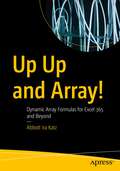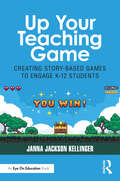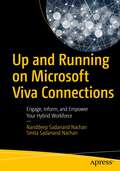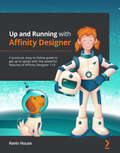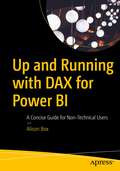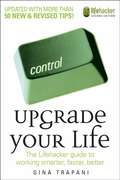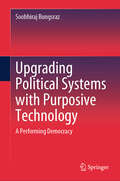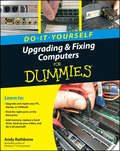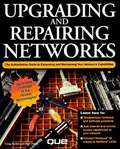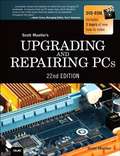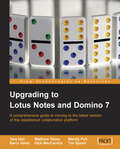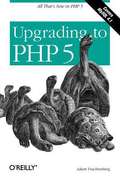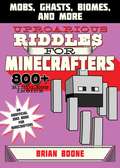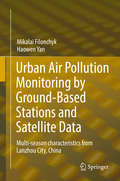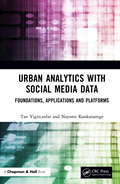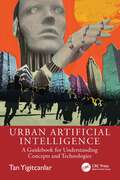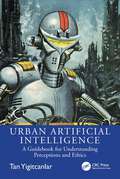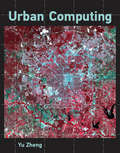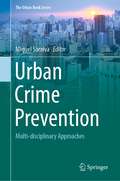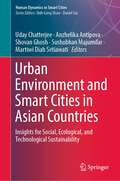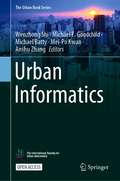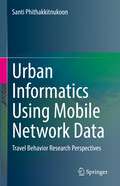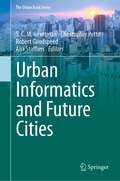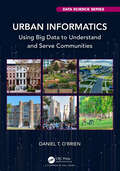- Table View
- List View
Up Up and Array!: Dynamic Array Formulas for Excel 365 and Beyond
by Abbott Ira KatzUnderstand the power of dynamic arrays: a single formula can generate new and vastly more efficient spreadsheet possibilities. This book introduces spreadsheet users to dynamic array functions in Microsoft Excel 365, defines and details the distinctive ways in which they work, and shows how they can be applied to a wide swath of data-analytic tasks.While array formulas and functions have long held a place in the spreadsheet toolbox (although, for many of us, shunted to an obscure corner), the dynamic array engine offers a more user-friendly and intelligible set of means for manipulating spreadsheet data in the array mode. The single-formula, multi-cell capability of dynamic arrays has been extended to nearly all existing spreadsheet functions, offering a new, default way of working. As a result, many tasks can now be executed with dynamic arrays without having to resort to the new functions at all.After defining arrays and dynamic array formulas, this book helps you examine the dynamic array property of lifting and how it impacts the formulas, including those written with existing functions. Plenty of illustrations and formulas along the way help you get comfortable using them. From there, you will learn Excel 365’s new dynamic functions, including the 14 currently in rollout, each accompanied by instructive examples. In many cases, the examples demonstrate how the new functions can work with long-available functions, such as MID, IF, COUNTIF, etc., which now also boast dynamic array functionality. What You Will LearnUnlock the dynamic array potential in Microsoft ExcelApply dynamic array functions and confidently direct them to real-world spreadsheet tasksKnow the distinctive ways in which arrays work and can be applied to numerous data-analytic tasksWho This Book Is ForUsers of Excel 365 and beyond who are comfortable with, but not necessarily expert in, formula writing, as well as those who are unaware of or not fluent with dynamic arrays. It is also valuable to data journalists and other professionals in need of spreadsheet skills who may unaware of dynamic arrays, and the time they could save by applying them to their work.
Up Your Teaching Game: Creating Story-Based Games to Engage K-12 Students
by Janna Jackson KellingerUp Your Teaching Game offers K-12 teachers an intuitive and refreshingly fun pathway for creating immersive, story-based games that encourage students to experience the curriculum through play. Regardless of their technical abilities, design acumen, grade level, or domain, today’s teachers have fresh opportunities to create and implement their own content-based games based on the same techniques that video game designers use to create commercial video games. In five actionable steps, this book prepares educators to design curricular games that teach instead of test, that are derived from content rather than divergent from it, and that motivate students to take ownership over their learning. Programs that most teachers are familiar with, such as PowerPoint and Google Slides, and technologies that may be new to them, such as Twine and Scratch, are addressed alongside the use of their own classrooms and schools as game spaces. Novice and veteran teachers alike, as well as curriculum designers and school technologists, will find a wealth of strategies and lessons learned, tips for avoiding pitfalls and time constraints, examples of quests and storyline advancement, and much more.
Up and Running on Microsoft Viva Connections: Engage, Inform, and Empower Your Hybrid Workforce
by Nanddeep Sadanand Nachan Smita Sadanand NachanLeverage the collaboration capabilities of Microsoft Viva Connections as an employee experience platform to build a gateway to your digital workplace. This book helps you set up Microsoft Viva connections via easy-to-follow steps and extend it to target your business scenarios.The book starts with an introduction to Microsoft Viva and its modules and it discusses Viva Connections for desktop and mobile users. You will learn about the intranet landing experience with SharePoint where you will plan, build, and launch a home site. You will know how to use the app bar and global navigation in Viva Connections and understand the importance of the dashboard and dashboard cards. You will learn how to enable Viva Connections in MS Teams and define a rollout strategy. You will gain experience with Viva Connections on mobile devices and go through end-user guidance. And you will learn to extend Viva Connections with the SharePoint Framework and deploy SPFx solutions. After reading this book, you will be able to set up Microsoft Viva Connections for your digital workplace and empower your employees to search and discover relevant news, information, content, and sites from across the organization.What Will You LearnUnderstand the modern experience in SharePoint with Microsoft Viva ConnectKnow best practices for your home site in SharePointGet your content ready for feed with SharePoint and YammerBuild Adaptive Card Extensions (ACEs) with SPFxDefine governance for Viva ConnectionsWho This Book Is ForMicrosoft professionals and business users who want to leverage the collaboration capabilities of Microsoft Viva Connections
Up and Running with Affinity Designer: A practical, easy-to-follow guide to getting up to speed with Affinity Designer
by Kevin HouseAdd Affinity Designer to your creative skillset while creating innovative designs and illustrations, building a solid foundation for your futureKey FeaturesUnderstand Affinity Designer's interface and setup, discover its capabilities, and develop an efficient workflowHarness the power of an easy and flexible vector and pixel workflow in one applicationLearn practical skills and gain the confidence to power your own creative projectsBook DescriptionAffinity Designer is a relatively new creative application and, in a reasonably short time, it has quickly become a powerhouse design and illustration application. Affinity Designer, along with Affinity Photo and Affinity Publisher, is part of a suite of award-winning creative software applications developed by Serif Europe. Built on the latest technologies, which make it fast and smooth, Affinity Designer is quickly becoming the go-to professional creative application for vector drawing and pixel-based painting.Up and Running with Affinity Designer is a comprehensive hands-on introduction to the Affinity Designer software. Whether you're new to the creative industry, a seasoned professional looking for a proven alternative, or an enthusiastic hobbyist, this book will help you get up to speed in no time. Complete with straightforward explanations and supporting hands-on exercises, this easy-to-follow guide will help you gain a solid foundation in Affinity Designer and form a base for in-depth exploration in your own projects.By the end of this Affinity Designer book, you'll have gained the knowledge and confidence to use Affinity Designer as part of your creative toolset.What you will learnExplore the interface and unique UX characteristics of Affinity DesignerDiscover features that allow you to manipulate and transform objectsApply color, shading, and effects to create unique compositionsEmploy layers to organize and simplify complex projectsUse grids, guides, and snapping features as design aidsAdapt to Affinity Designer's custom workspaces and keyboard shortcutsExplore the workflow and design best practices for more predictable and successful outcomesIdentify potential stumbling blocks in your design process and learn how to avoid themWho this book is forThis Affinity Designer book is for graphic designers, artists, illustrators, and hobbyists. Anyone curious about Affinity Designer's unique toolset and vector and pixel workflows or looking for cost-effective alternatives to the Adobe suite will find this book useful. Experience in working with other similar tools will be helpful, but not necessary.
Up and Running with DAX for Power BI: A Concise Guide for Non-Technical Users
by Alison BoxTake a concise approach to learning how DAX, the function language of Power BI and PowerPivot, works. This book focuses on explaining the core concepts of DAX so that ordinary folks can gain the skills required to tackle complex data analysis problems. But make no mistake, this is in no way an introductory book on DAX. A number of the topics you will learn, such as the concepts of context transition and table expansion, are considered advanced and challenging areas of DAX.While there are numerous resources on DAX, most are written with developers in mind, making learning DAX appear an overwhelming challenge, especially for those who are coming from an Excel background or with limited coding experience. The reality is, to hit the ground running with DAX, it’s not necessary to wade through copious pages on rarified DAX functions and the technical aspects of the language. There are just a few mandatory concepts that must be fully understood before DAX can be mastered. Knowledge of everything else in DAX is built on top of these mandatory aspects. Author Alison Box has been teaching and working with DAX for over eight years, starting with DAX for PowerPivot, the Excel add-in, before moving into the Power BI platform. The guide you hold in your hands is an outcome of these years of experience explaining difficult concepts in a way that people can understand. Over the years she has refined her approach, distilling down the truth of DAX which is “you can take people through as many functions as you like, but it’s to no avail if they don’t truly understand how it all works.” You will learn to use DAX to gain powerful insights into your data by generating complex and challenging business intelligence calculations including, but not limited to:Calculations to control the filtering of information to gain better insight into the data that matters to youCalculations across dates such as comparing data for the same period last year or the previous periodFinding rolling averages and rolling totalsComparing data against targets and KPIs or against average and maximum valuesUsing basket analysis, such as “of customers who bought product X who also bought product Y”Using “what if” analysis and scenariosFinding “like for like” salesDynamically showing TopN/BottomN percent of customers or products by salesFinding new and returning customers or sales regions in each month or each year Who This Book Is ForExcel users and non-technical users of varying levels of ability or anyone who wants to learn DAX for Power BI but lacks the confidence to do so
Upgrade Your Life
by Gina TrapaniWhether you?re a Mac or Windows user, there are tricks here for you in this helpful resource. You?ll feast on this buffet of new shortcuts to make technology your ally instead of your adversary, so you can spend more time getting things done and less time fiddling with your computer. You?ll learn valuable ways to upgrade your life so that you can work?and live?more efficiently, such as: empty your e-mail inbox, search the Web in three keystrokes, securely save Web site passwords, automatically back up your files, and many more.
Upgrading Political Systems with Purposive Technology: A Performing Democracy
by Soobhiraj BungsrazThis book presents a framework for designing and implementing technologies to reduce risks in parliamentary decision-making, leading to the emergence of e-politics. It emphasizes adaptable virtual systems and problem-solving over predefined solutions, fostering multi-helix engagement among cross-functional teams. These teams collaborate to develop strategic, tactical, and operational solutions for citizens, elected parliamentarians, and organizations such as the UN. The book underscores the importance of risk identification, mitigation, and communication for e-political system safety. The framework leverages technology to create an e-democracy, enhancing the productivity of parliamentarians and promoting democratic sustainability. It builds on the theoretical framework of system engineering, aiming to avoid the pitfalls of previous generations' promises and instead focusing on continuous improvement through a people-centric system. The book introduces the PI App as a purposive technology that aids in implementing these ideas. By promoting an ever-improving parliament and parliamentarians, the framework aims to achieve higher productivity in decision-making roles and evolve practical e-democracy. It highlights the need for a Virtuous Cycle for continuous improvement in strategic decisions for national investment, ultimately leading to a people-centric system. The book envisions a future where technology plays a crucial role in ensuring democratic sustainability and enhancing the effectiveness of parliamentary decision-making.
Upgrading and Fixing Computers Do-it-Yourself For Dummies
by Andy RathboneAn illustrated, step-by-step guide to repairs and upgradesWhether you want to prepare your computer for Windows 7, avoid investing in a new one, or just "go green", this fully illustrated guide has what you need. You'll learn how to add printers and new keyboards, boost your PC's performance and increase memory, improve power consumption, rev up your multimedia capacity, and much more. Step-by-step instructions are accompanied by photos that show you exactly what you should see at every stage.Learn to perform basic upgrades and prepare your PC for high-speed Internet connections, network connections, and added security, all with fully illustrated instructionsFind out how to expand memory, enhance speed, and update your computer's power supplyPrepare an old computer for Windows 7 and beef up your capacity for multimediaUpgrading & Fixing Computers Do-It-Yourself For Dummies is a show-and-tell course in making your PC happy, healthy, and green.
Upgrading and Repairing Networks
by Craig Zacker Paul DoyleA well-rounded source for all network needs, whether upgrades, troubleshooting, expansion, or repair. General "buyer's guide" information helps the reader make decisions while the abundance of how-to and troubleshooting tips helps with the day-to-day maintenance and operation tasks.
Upgrading and Repairing PCs 22nd Edition
by Scott M. MuellerFor more than 25 years, Upgrading and Repairing PCs has been the world''s #1 guide to PC hardware: The single source for reliable information on how PCs work, troubleshooting and fixing problems, adding hardware, optimizing performance, and building new PCs. Scott Mueller delivers practical answers about PC processors, mother-boards, buses, BIOSes, memory, SSD and HDD storage, video, audio, networks, Internet connectivity, power, and much more. You''ll find the industry''s best coverage of diagnostics, testing, and repair--plus cutting-edge discussions of improving PC performance via overclocking and other techniques. Mueller has taught thousands of professionals in person and millions more through his books and videos--nobody knows more about keeping PCs running perfectly. Whether you''re a professional technician, a small business owner trying to save money, or a home PC enthusiast, this is the only PC hardware book you need!
Upgrading to Lotus Notes and Domino 7
by Matthew Henry Dick MccarrickEstablished Lotus experts provide you with a systematic tour of the essential new Lotus features, and how to get maximum use from them. Administrators and developers working with any version of Lotus Notes/Domino, and needing the low-down on how to successfully make the most of the 7.0 upgrade. Another benefit is you can use this book to help you pass the 190-702 Update exam. This book covers the important exam topics.
Upgrading to PHP 5
by Adam TrachtenbergThis new book is targeted toward PHP developers who are already familiar with PHP 4. Upgrading to PHP 5 offers a concise appraisal of the differences between PHP 4 and PHP 5, a detailed look at what's new in this latest version, and an explanation of how these changes affect you. The book also covers more advanced features and provides hands-on experienced through short, sample programs included throughout.
Upkar’s UGC NET/JRF/SET Computer Science & Applications (Paper-II & III) - competitive exam
by Chandresh Shah Saurab Mishra Sunil Kumar OjhaThis book contains topics on Computer Architecture and Circuit Design, Introduction to Database Concepts, Computer Graphics, Programming Language Concepts, Data Communication and Networking, Data Structures and Algorithms, Object-oriented Analysis and Design, System Analysis and Designing, Operating System Concepts and Artificial Intelligence. Objective Questions and Syllabus are addition features of this book.
Uproarious Riddles for Minecrafters: Mobs, Ghasts, Biomes, and More (Jokes for Minecrafters)
by Brian Boone Amanda BrackUproarious Riddles for Minecrafters is the fifth book in the Jokes for Minecrafters series, which is complete with more than eight hundred riddles! "Dig in" to these funny brainteasers about Minecraft mobs, tools, and biomes that will really make you think! You'll have such a BLAST reading all of these crafty riddles and jokes. All of your favorite parts of the Minecraft game are included in the book, and the riddles will have you continuing the Minecraft fun! <p><p> For kids ages five and up, this is the perfect book for at home, at school, or really anywhere! You’ll enjoy telling these silly jokes to your friends and family. As a bonus there are silly illustrations throughout for extra laughs!
Urban Air Pollution Monitoring by Ground-Based Stations and Satellite Data: Multi-season Characteristics From Lanzhou City, China
by Haowen Yan Mikalai FilonchykThis book examines air pollution of a big city using multi-year and multi-season data from ground-based air monitoring stations and satellite sounding data, which provides more clear and detailed information on the main sources of air pollution, the long-term trend of pollution, the influence of meteorological parameters on pollution levels, and trajectories of polluted air masses. For example, the book shows that particulate matter from local sources is transported from deserts to create air quality challenges. It also analyzes the effects of desert and semi-desert landscapes on high concentrations of pollutants.
Urban Analytics with Social Media Data: Foundations, Applications and Platforms
by Tan Yigitcanlar Nayomi KankanamgeThe use of data science and urban analytics has become a defining feature of smart cities. This timely book is a clear guide to the use of social media data for urban analytics. The book presents the foundations of urban analytics with social media data, along with real-world applications and insights on the platforms we use today. It looks at social media analytics platforms, cyberphysical data analytics platforms, crowd detection platforms, City-as-a-Platform, and city-as-a-sensor for platform urbanism. The book provides examples to illustrate how we apply and analyse social media data to determine disaster severity, assist authorities with pandemic policy, and capture public perception of smart cities. This will be a useful reference for those involved with and researching social, data, and urban analytics and informatics.
Urban Artificial Intelligence: A Guidebook for Understanding Concepts and Technologies
by Tan YigitcanlarTan Yigitcanlar offers a comprehensive exploration of artificial intelligence’s (AI) role in shaping modern cities. This volume delves into how AI‑driven analytics and big data provide city planners with deeper insights, enabling more informed decision‑making. These insights lead to more efficient resource use, improved public services, and better infrastructure management.In the digital age, AI is revolutionising various sectors, fundamentally altering our approach to problem‑solving and innovation. AI’s transformative power spans industries from healthcare to finance, and now, it is poised to redefine urban planning and development. Urban areas, as the epicentres of human activity and progress, face myriad challenges such as population growth, resource management, environmental sustainability, and infrastructure development. Traditional methods often fall short in addressing these complexities, making the integration of AI an essential frontier. Comprising seven extensive and insightful chapters, this volume bridges the gap between the theoretical potential and practical implementation of AI in urban contexts. It covers foundational concepts of urban AI, examines its applications across different domains, and explores how AI can improve urban life through smarter home technologies and personalised public services.This first volume is complemented by Urban Artificial Intelligence: A Guidebook for Understanding Perceptions and Ethics, which delves into the ethical and perceptual dimensions of AI in urban settings. Together, these volumes provide a holistic view of urban artificial intelligence, offering essential insights for urban planners, policymakers, researchers, and anyone interested in the intersection of AI and urban development.
Urban Artificial Intelligence: A Guidebook for Understanding Perceptions and Ethics
by Tan YigitcanlarThis volume thoroughly explores the perceptions and ethical considerations surrounding urban artificial intelligence (AI). Tan Yigitcanlar delves into the complex public and professional views on AI, offering invaluable insights for policymakers, urban planners, and developers.As the world rapidly advances technologically, the role of AI has become increasingly significant. AI’s transformative power spans various sectors, revolutionising how we operate and innovate in fields such as healthcare, finance, agriculture, and space exploration. Despite its wide‑reaching impact, the integration of AI into urban planning and development remains relatively underexplored. This is surprising given AI’s immense potential to revolutionise urban design, management, and experience. Comprising eight comprehensive and insightful chapters, this book examines AI’s role in urban contexts, including its applications, public perceptions, and ethical implications. The first part of the guidebook delves into varied perceptions of AI within different urban sectors, presenting detailed perception analyses on AI’s role in urban planning, local government services, disaster management, and the construction industry. The second part shifts focus to the ethical implications and responsible implementation of AI in urban settings. It provides frameworks and strategies to ensure AI technologies contribute positively to urban development while mitigating potential risks and ethical concerns.This volume, alongside its companion Urban Artificial Intelligence: A Guidebook for Understanding Concepts and Technologies, offers a holistic view of Urban Artificial Intelligence. Together, these books provide essential insights for urban planners, policymakers, researchers, and anyone interested in AI and urban development, guiding responsible AI integration to foster smarter, more sustainable, and equitable urban environments.
Urban Computing (Information Systems)
by Yu ZhengAn authoritative treatment of urban computing, offering an overview of the field, fundamental techniques, advanced models, and novel applications.Urban computing brings powerful computational techniques to bear on such urban challenges as pollution, energy consumption, and traffic congestion. Using today's large-scale computing infrastructure and data gathered from sensing technologies, urban computing combines computer science with urban planning, transportation, environmental science, sociology, and other areas of urban studies, tackling specific problems with concrete methodologies in a data-centric computing framework. This authoritative treatment of urban computing offers an overview of the field, fundamental techniques, advanced models, and novel applications.Each chapter acts as a tutorial that introduces readers to an important aspect of urban computing, with references to relevant research. The book outlines key concepts, sources of data, and typical applications; describes four paradigms of urban sensing in sensor-centric and human-centric categories; introduces data management for spatial and spatio-temporal data, from basic indexing and retrieval algorithms to cloud computing platforms; and covers beginning and advanced topics in mining knowledge from urban big data, beginning with fundamental data mining algorithms and progressing to advanced machine learning techniques. Urban Computing provides students, researchers, and application developers with an essential handbook to an evolving interdisciplinary field.
Urban Crime Prevention: Multi-disciplinary Approaches (The Urban Book Series)
by Miguel SaraivaThis book provides an original cross-thematic and wide scope review of crime prevention processes in urban areas that are explicitly based on the cooperation between different scientific and professional fields. Focusing primarily on environmental and community-based crime prevention, this book compiles a peer-reviewed collection of papers and prospective essays that explore how, and to what extent, multi-disciplinarity can be used as a cornerstone for achieving safer cities.Relying on the input from specialists, researchers, decision-makers, and practitioners from around the world, it covers the various stages from theory to implementation, by discussing theoretical stances, interpreting policy and planning guidelines, uncovering unique educational experiences, and narrating insights and lessons learned from innovative research and practice. Hence, it provides vivid discussions and invaluable insights into processes of partnership building, planning, and management, oriented towards establishing successful mechanism for preventing crime and reducing feelings of insecurity in urban areas.
Urban Environment and Smart Cities in Asian Countries: Insights for Social, Ecological, and Technological Sustainability (Human Dynamics in Smart Cities)
by Anzhelika Antipova Uday Chatterjee Sushobhan Majumdar Martiwi Diah Setiawati Shovan GhoshThis book offers a thorough description of the challenges posed by increasing global urbanization. In addition, comprehensive perspectives are offered on how the contemporary urban challenges of our time are tackled by existing designers, architects, urban planners, and landscape architects thereby considering climate change, migration, resilience, politics, and environmental degradation. It includes insights from environmental design, geography, strategic planning, and engineering design. It goes beyond the jargon of technical innovation, and exposes the political, social and physical effects of digitalizing the world in smart cities. The book focuses on the application of geospatial technology of smart cities – including system design for basic services, real-time control and the Internet of Things. It highlights the planning of land use, strategic development, and ecosystem-based knowledge to enhance economic growth and healthy urban environment and smart city management. The book also shows the contradictory aspects of smart city studies, and provides useful insights into the creation and execution of policies to strengthen decision-making processes in smart cities. This book leads the reader to a greater understanding of smart city growth, both theoretical and realistic and as such it provides an interesting read for urban geographers, urban designers and planners, environmental specialists, practitioners, students.
Urban Informatics (The Urban Book Series)
by Michael Batty Wenzhong Shi Mei-Po Kwan Michael F. Goodchild Anshu ZhangThis open access book is the first to systematically introduce the principles of urban informatics and its application to every aspect of the city that involves its functioning, control, management, and future planning. It introduces new models and tools being developed to understand and implement these technologies that enable cities to function more efficiently – to become ‘smart’ and ‘sustainable’. The smart city has quickly emerged as computers have become ever smaller to the point where they can be embedded into the very fabric of the city, as well as being central to new ways in which the population can communicate and act. When cities are wired in this way, they have the potential to become sentient and responsive, generating massive streams of ‘big’ data in real time as well as providing immense opportunities for extracting new forms of urban data through crowdsourcing. This book offers a comprehensive review of the methods that form the core of urban informatics from various kinds of urban remote sensing to new approaches to machine learning and statistical modelling. It provides a detailed technical introduction to the wide array of tools information scientists need to develop the key urban analytics that are fundamental to learning about the smart city, and it outlines ways in which these tools can be used to inform design and policy so that cities can become more efficient with a greater concern for environment and equity.
Urban Informatics Using Mobile Network Data: Travel Behavior Research Perspectives
by Santi PhithakkitnukoonThis book discusses the role of mobile network data in urban informatics, particularly how mobile network data is utilized in the mobility context, where approaches, models, and systems are developed for understanding travel behavior. The objectives of this book are thus to evaluate the extent to which mobile network data reflects travel behavior and to develop guidelines on how to best use such data to understand and model travel behavior. To achieve these objectives, the book attempts to evaluate the strengths and weaknesses of this data source for urban informatics and its applicability to the development and implementation of travel behavior models through a series of the authors’ research studies.Traditionally, survey-based information is used as an input for travel demand models that predict future travel behavior and transportation needs. A survey-based approach is however costly and time-consuming, and hence its information can be dated and limited to a particular region. Mobile network data thus emerges as a promising alternative data source that is massive in both cross-sectional and longitudinal perspectives, and one that provides both broader geographic coverage of travelers and longer-term travel behavior observation. The two most common types of travel demand model that have played an essential role in managing and planning for transportation systems are four-step models and activity-based models. The book’s chapters are structured on the basis of these travel demand models in order to provide researchers and practitioners with an understanding of urban informatics and the important role that mobile network data plays in advancing the state of the art from the perspectives of travel behavior research.
Urban Informatics and Future Cities (The Urban Book Series)
by Robert Goodspeed Christopher Pettit S. C. M. Geertman Aija StaffansThis book forms a selection of chapters submitted for the CUPUM (Computational Urban Planning and Urban Management) conference, held in the second week of June 2021 at Aalto University in Helsinki, Finland. Chapters were selected from a double-blind review process by the conference's scientific committee. The chapters in the book cover developments and applications with big data and urban analytics, collaborative urban planning, applications of geodesign and innovations, and planning support science.
Urban Informatics: Using Big Data to Understand and Serve Communities (Chapman & Hall/CRC Data Science Series)
by Daniel T. O'BrienUrban Informatics: Using Big Data to Understand and Serve Communities introduces the reader to the tools of data management, analysis, and manipulation using R statistical software. Designed for undergraduate and above level courses, this book is an ideal onramp for the study of urban informatics and how to translate novel data sets into new insights and practical tools. The book follows a unique pedagogical approach developed by the author to enable students to build skills by pursuing projects that inspire and motivate them. Each chapter has an Exploratory Data Assignment that prompts readers to practice their new skills on a data set of their choice. These assignments guide readers through the process of becoming familiar with the contents of a novel data set and communicating meaningful insights from the data to others. Key Features: The technical curriculum consists of both data management and analytics, including both as needed to become acquainted with and reveal the content of a new data set. Content that is contextualized in real-world applications relevant to community concerns. Unit-level assignments that educators might use as midterms or otherwise. These include Community Experience assignments that prompt students to evaluate the assumptions they have made about their data against real world information. All data sets are publicly available through the Boston Data Portal.
